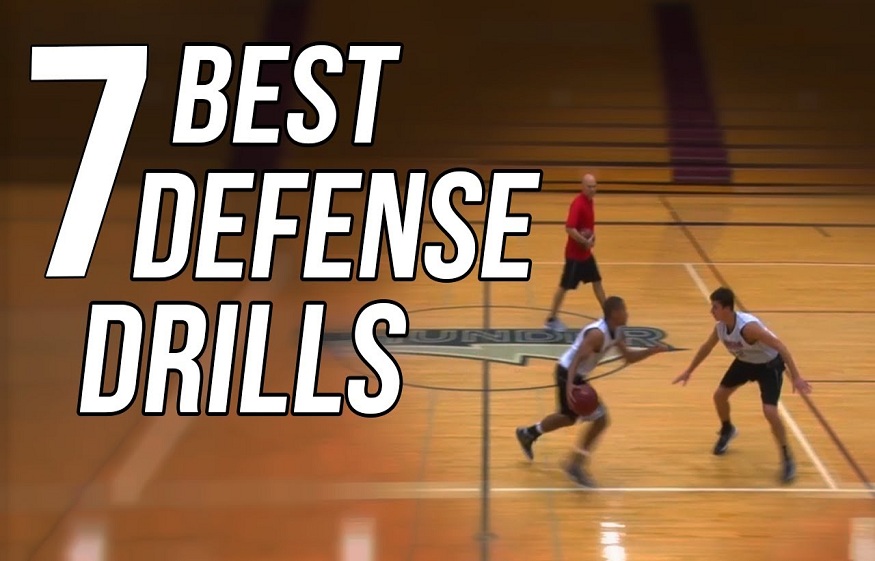Let us share with you a harsh truth: just being ready to hustle and play hard on defense is not sufficient. To establish a successful defensive squad, people coaching basketball shooting must get their players must acquire a proper defensive technique and understand where they should be on the floor based on who they are defending and where the basketball is in relation to their location on the court.
This may be accomplished most effectively by including proven basketball defensive exercises into your team’s practice sessions. On the defensive end of the court, the aim is to push the opponent into attempting the most challenging shot possible to win the game.
This necessitates players being able to play excellent on-ball defense, as well as help defense, learn the best shooting drills for basketball, and be ready to rotate and assist when necessary.
What Are Basketball Defense Drills?
Basketball defense drills are activities that are designed to improve a player’s defensive performance. These exercises, which often include defensive footwork, defensive rebounding methods, and the defensive stance, are designed to help players develop the fundamental abilities of a solid defensive game. There are defensive exercises for single individuals, groups of players, and complete teams to choose from!
Benefits of Defense Drills
Apart from working on offensive tactics such as ball handling, layups, individual shooting drills basketball, passing, and finishing, it is essential to improve defensive abilities as well. Defensive exercises may help you improve your footwork while also preventing your opponents from shooting, passing, and scoring. They can also help you improve your basics. Their individual and team rhythms may be disrupted if they play good defense, which will push them to attempt more tough shots.
7 Basketball Defense Drills
There are a variety of defensive basketball workouts that you may do to improve your man-to-man or zone defense skills. As is often the case, incorporate these exercises into your existing routines while making sure to include warm-ups first. Here are a couple of illustrations:
- One-on-one full court: In this practice, two players start at opposite ends of the floor and work their way across the court. In this scenario, the coach throws the ball to the offensive player, who is then guarded by the ball defender as he dribbles down the length of the court in an effort to score. After that, the players reverse roles, with the offensive player defending while the offense launches a charge for the opposing basket. One variant is to limit the practice to the half-court area.
- Coordinated movements: Spread out all of the participants at equal intervals on the court, with their backs to one side of the court and their arms crossed in a defensive position. Aside from calling out which actions to complete, the coach instructs the players on how to perform them rapidly, moving between high-intensity workouts such as close-outs, defensive slides, charges, and backpedals.
- Three cone hurdles: For this exercise, place three cones two feet apart on the ground. Through the cones, the participant will complete lateral hurdles with their knees bent. The activity should be completed swiftly, with the outer foot landing after the final cone before switching direction. This will help with agility, lateral quickness, and speed, to name a few characteristics.
- Crossover-slide-sprint: The player or players slide into a defensive posture, cross over, and then return to a sliding position again. Change up the slide with a full sprint and then back to a slide again to keep things interesting. The goal is to become more proficient at making quick transitions between the various movement types.
- Zig-zag: Two players line up near each other in the same corner of the court to begin the match. In the next phase, the offensive player will dribble. In contrast, the defensive player remains in a low defensive posture, protecting them as they go down the lane on the other side. Across the court, they should form a zigzag pattern. Have them exchange places when they reach the other corner. When they get to the other corner, they should switch positions.
- Shell drill: Team defensive drills like these are pretty effective. Four offensive players set up along the three-point line: two towards the top of the key and one in each corner of the huddle. There should be four defensive players around the baseline. It is passed to one of the players at the top of the three-point line. The defenders are required to race to their corresponding player and then shift as the basketball is passed among the four attacking players. They should all shift their defensive positions depending on where the ball is.
- Box out defending rebound drill: Two players will take up positions beyond the top of the key, in the free throw lane in front of the basket, one on offense and one on defense. Place a ball precisely behind the hoop for added effect. Whenever the coach signals, the defensive player will use defensive box out movements to attempt to keep the offensive player away from the ball for as long as he possibly can.
Conclusion:
As someone coaching basketball shooting, you must first teach the fundamentals of basketball to anybody working with young people or students in high school. Positioning, communication, and effort will help you defend yourself. You’ll be more prepared to deal with whatever the offense has in store for you. Take advantage of kids’ basketball defense exercises in order to build up your players’ skills. This enables a young person to learn how to play basketball and win games.

